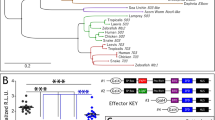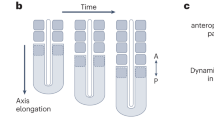Abstract
Somitogenesis requires bilateral rhythmic segmentation of paraxial mesoderm along the antero-posterior axis1. The location of somite segmentation depends on opposing signalling gradients of retinoic acid (generated by retinaldehyde dehydrogenase-2; Raldh2) anteriorly and fibroblast growth factor (FGF; generated by Fgf8) posteriorly2,3. Retinoic-acid-deficient embryos exhibit somite left–right asymmetry4,5,6, but it remains unclear how retinoic acid mediates left–right patterning. Here, we demonstrate that retinoic-acid signalling is uniform across the left–right axis and occurs in node ectoderm but not node mesoderm. In Raldh2−/− mouse embryos, ectodermal Fgf8 expression encroaches anteriorly into node ectoderm and neural plate, but its expression in presomitic mesoderm is initially unchanged. The late stages of somitogenesis were rescued in Raldh2−/− mouse embryos when the maternal diet was supplemented with retinoic acid until only the 6-somite stage, demonstrating that retinoic acid is only needed during node stages. A retinoic-acid-reporter transgene marking the action of maternal retinoic acid in rescued Raldh2−/− embryos revealed that the targets of retinoic-acid signalling during somitogenesis are the node ectoderm and the posterior neural plate, not the presomitic mesoderm. Our findings suggest that antagonism of Fgf8 expression by retinoic acid occurs in the ectoderm and that failure of this mechanism generates excessive FGF8 signalling to adjacent mesoderm, resulting initially in smaller somites and then left–right asymmetry.
This is a preview of subscription content, access via your institution
Access options
Subscribe to this journal
Receive 12 print issues and online access
$209.00 per year
only $17.42 per issue
Buy this article
- Purchase on Springer Link
- Instant access to full article PDF
Prices may be subject to local taxes which are calculated during checkout





Similar content being viewed by others
References
Pourquié, O. The segmentation clock: converting embryonic time into spatial pattern. Science 301, 328–330 (2003).
Del Corral, R.D. et al. Opposing FGF and retinoid pathways control ventral neural pattern, neuronal differentiation, and segmentation during body axis extension. Neuron 40, 65–79 (2003).
Moreno, T.A. & Kintner, C. Regulation of segmental patterning by retinoic acid signaling during Xenopus somitogenesis. Dev. Cell 6, 205–218 (2004).
Vermot, J. et al. Retinoic acid controls the bilateral symmetry of somite formation in the mouse embryo. Science 308, 563–566 (2005).
Vermot, J. & Pourquié, O. Retinoic acid coordinates somitogenesis and left–right patterning in vertebrate embryos. Nature 435, 215–220 (2005).
Kawakami, Y. et al. Retinoic acid signalling links left-right asymmetric patterning and bilaterally symmetric somitogenesis in the zebrafish embryo. Nature 435, 165–171 (2005).
Dubrulle, J., McGrew, M.J. & Pourquié, O . FGF signaling controls somite boundary position and regulates segmentation clock control of spatiotemporal Hox gene activation. Cell 106, 219–232 (2001).
Aulehla, A. & Herrmann, B.G. Segmentation in vertebrates: clock and gradient finally joined. Genes Dev. 18, 2060–2067 (2004).
Molotkova, N., Molotkov, A., Sirbu, I.O. & Duester, G. Requirement of mesodermal retinoic acid generated by Raldh2 for posterior neural transformation. Mech. Dev. 122, 145–155 (2005).
Niederreither, K. et al. Embryonic retinoic acid synthesis is essential for heart morphogenesis in the mouse. Development 128, 1019–1031 (2001).
Molotkov, A. et al. Stimulation of retinoic acid production and growth by ubiquitously-expressed alcohol dehydrogenase Adh3. Proc. Natl Acad. Sci. USA 99, 5337–5342 (2002).
Niederreither, K., Subbarayan, V., Dollé, P. & Chambon, P. Embryonic retinoic acid synthesis is essential for early mouse post-implantation development. Nature Genet. 21, 444–448 (1999).
Mic, F.A., Haselbeck, R.J., Cuenca, A.E. & Duester, G. Novel retinoic acid generating activities in the neural tube and heart identified by conditional rescue of Raldh2 null mutant mice. Development 129, 2271–2282 (2002).
Mic, F.A., Molotkov, A., Benbrook, D.M. & Duester, G. Retinoid activation of retinoic acid receptor but not retinoid X receptor is sufficient to rescue lethal defect in retinoic acid synthesis. Proc. Natl Acad. Sci. USA 100, 7135–7140 (2003).
Rossant, J. et al. Expression of a retinoic acid response element-hsplacZ transgene defines specific domains of transcriptional activity during mouse embryogenesis. Genes Dev. 5, 1333–1344 (1991).
Tanaka, Y., Okada, Y. & Hirokawa, N. FGF-induced vesicular release of Sonic hedgehog and retinoic acid in leftward nodal flow is critical for left–right determination. Nature 435, 172–177 (2005).
Morimoto, M., Takahashi, Y., Endo, M. & Saga, Y. The Mesp2 transcription factor establishes segmental borders by suppressing Notch activity. Nature 435, 354–359 (2005).
Bussen, M. et al. The T-box transcription factor Tbx18 maintains the separation of anterior and posterior somite compartments. Genes Dev. 18, 1209–1221 (2004).
Sirbu, I.O., Gresh, L., Barra, J. & Duester, G. Shifting boundaries of retinoic acid activity control hindbrain segmental gene expression. Development 132, 2611–2622 (2005).
MacLean, G. et al. Cloning of a novel retinoic-acid metabolizing cytochrome P450, Cyp26B1, and comparative expression analysis with Cyp26A1 during early murine development. Mech. Dev. 107, 195–201 (2001).
Noy, N. Retinoid-binding proteins: mediators of retinoid action. Biochem. J. 348, 481–495 (2000).
Ruberte, E., Dolle, P., Chambon, P. & Morriss–Kay, G. Retinoic acid receptors and cellular retinoid binding proteins. II. Their differential pattern of transcription during early morphogenesis in mouse embryos. Development 111, 45–60 (1991).
Qiu, Y., Tsai, S.Y. & Tsai, M.–J. COUP–TF: An orphan member of the steroid–thyroid hormone receptor superfamily. Trends Endocrinol. Metab. 5, 234–239 (1994).
Perantoni, A.O. et al. Inactivation of FGF8 in early mesoderm reveals an essential role in kidney development. Development 132, 3859–3871 (2005).
Meyers, E.N. & Martin, G.R. Differences in left–right axis pathways in mouse and chick: functions of FGF8 and SHH. Science 285, 403–406 (1999).
Molotkov, A., Molotkova, N. & Duester, G. Retinoic acid generated by Raldh2 in mesoderm is required for mouse dorsal endodermal pancreas development. Dev. Dyn. 232, 950–957 (2005).
Mansouri, A. et al. Paired-related murine homeobox gene expressed in the developing sclerotome, kidney, and nervous system. Dev. Dyn. 210, 53–65 (1997).
Kim, S.H. et al. The role of paraxial protocadherin in selective adhesion and cell movements of the mesoderm during Xenopus gastrulation. Development 125, 4681–4691 (1998).
Acknowledgements
We thank the following for mouse cDNAs used to prepare in situ hybridization probes: G. Martin (Fgf8), Y. Saga (Mesp2), E. DeRobertis (Papc), A. Kispert (Tbx18), V. Giguere (Crabp2), M. Tsai (COUP–TFII) and A. Mansouri (Uncx4.1). We also thank J. Rossant for providing RARE–lacZ mice, and A. Molotkov, N. Molotkova and X. Zhao for helpful discussions. This work was funded by National Institutes of Health grant GM62848.
Author information
Authors and Affiliations
Corresponding author
Ethics declarations
Competing interests
The authors declare no competing financial interests.
Rights and permissions
About this article
Cite this article
Sirbu, I., Duester, G. Retinoic-acid signalling in node ectoderm and posterior neural plate directs left–right patterning of somitic mesoderm. Nat Cell Biol 8, 271–277 (2006). https://doi.org/10.1038/ncb1374
Received:
Accepted:
Published:
Issue Date:
DOI: https://doi.org/10.1038/ncb1374
This article is cited by
-
Intercellular exchange of Wnt ligands reduces cell population heterogeneity during embryogenesis
Nature Communications (2023)
-
From pluripotency to myogenesis: a multistep process in the dish
Journal of Muscle Research and Cell Motility (2015)
-
A complex RARE is required for the majority of Nedd9 embryonic expression
Transgenic Research (2015)
-
Environmental aspects of congenital scoliosis
Environmental Science and Pollution Research (2015)
-
Retinoic acid regulates olfactory progenitor cell fate and differentiation
Neural Development (2013)



